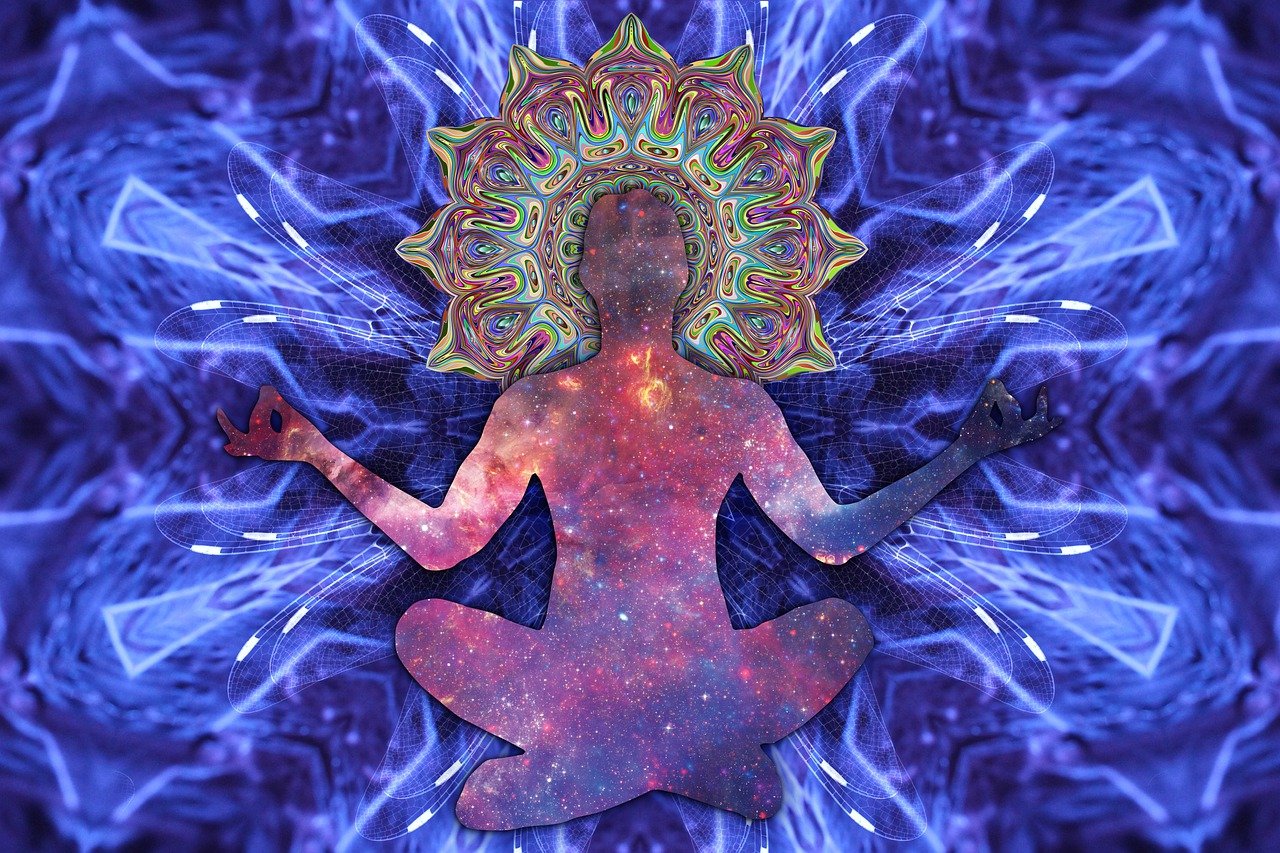Raja Yoga: Mastery of Mind and Spirit

Hey there, amazing readers! 🖐️ Just a quick note: yes, we know there are a lot of ads here. Trust us, we get it—it’s not the prettiest look, but they help us keep this blog alive and kicking. Those pesky little ads cover the costs of all the behind-the-scenes magic, from hosting and tech stuff to creating content we hope you’ll love.
We’re committed to delivering quality posts, and your support (even just sticking around despite the ads) means everything to us. So, bear with us, and thanks for helping us keep the good vibes rolling. Now, on to the fun stuff! 😉
TRANSLATE BUTTON AT THE END OF THE ARTICLE
Introduction to Raja Yoga
Raja Yoga, also known as the royal path of yoga, is a spiritual and philosophical practice that focuses on mastering the mind and spirit to achieve a higher state of consciousness.
Unlike other forms of yoga that primarily focus on physical postures, Raja Yoga delves deep into the psychology of the mind and aims to bring about mental clarity, emotional balance, and spiritual enlightenment.
Through a series of practices and techniques, practitioners of Raja Yoga seek to quiet the mind, control their thoughts, and ultimately transcend the limitations of the material world.
Understanding the Mind-Body Connection
Raja Yoga emphasizes the intricate connection between the mind and body, teaching practitioners that mastering the mind is essential for achieving spiritual growth.
The belief is that the mind influences the body, and vice versa, creating a delicate balance that must be maintained for overall well-being.
By cultivating self-awareness and mindfulness, individuals practicing Raja Yoga can gain a deeper understanding of their thoughts and emotions, leading to greater control over their actions and reactions.
This mind-body awareness is at the core of Raja Yoga practices, guiding practitioners towards a state of inner peace and harmony.
History and Origins of Raja Yoga
The origins of Raja Yoga can be traced back to ancient India, where it was first documented in the Yoga Sutras of Patanjali, a foundational text that outlines the principles and practices of this spiritual path.
Patanjali, often referred to as the father of yoga, compiled the Yoga Sutras around 400 CE, codifying the teachings of Raja Yoga for future generations.
Over the centuries, Raja Yoga has evolved and adapted to different cultural contexts, but its core principles have remained consistent, emphasizing self-discipline, meditation, and self-realization as the key components of spiritual growth.
Principles and Philosophy of Raja Yoga
At the heart of Raja Yoga are the principles of self-control, self-discipline, and self-awareness.
Practitioners are encouraged to cultivate virtues such as patience, compassion, and humility, in order to purify the mind and elevate the spirit.
The philosophy of Raja Yoga revolves around the idea that the true self, or Atman, is distinct from the physical body and mind, and that by transcending the ego and the senses, one can experience union with the divine.
Through practices such as meditation, concentration, and ethical living, individuals can awaken their inner potential and realize their true nature.
The Eight Limbs of Raja Yoga
Raja Yoga is often referred to as the "eight-limbed path," as outlined in the Yoga Sutras of Patanjali.
These eight limbs are ethical guidelines and practices that serve as a roadmap for spiritual growth and self-realization.
The limbs are as follows:
Yama (moral restraints)
Niyama (observances)
Asana (physical postures)
Pranayama (breath control)
Pratyahara (withdrawal of the senses)
Dharana (concentration)
Dhyana (meditation)
Samadhi (union with the divine)
Each limb of Raja Yoga plays a crucial role in the journey towards self-discovery and spiritual enlightenment, guiding practitioners towards a state of inner peace and union with the divine.
Benefits of Practicing Raja Yoga
Practicing Raja Yoga offers a wide range of benefits for the mind, body, and spirit.
Some of the key advantages include:
Improved mental clarity and focus
Reduced stress and anxiety
Enhanced emotional well-being
Increased self-awareness and mindfulness
Greater sense of inner peace and balance
Improved physical health and flexibility
Heightened spiritual awareness and connection
By incorporating Raja Yoga practices into daily life, individuals can experience profound transformation and personal growth, leading to a more fulfilling and meaningful existence.
Techniques for Mastering the Mind
Raja Yoga employs various techniques to help practitioners master the mind and achieve mental clarity.
These techniques include:
Meditation: By practicing meditation regularly, individuals can quiet the mind, cultivate inner stillness, and develop a deeper connection to their true selves.
Breath control: Through pranayama techniques, practitioners can regulate their breath, calm the nervous system, and increase energy levels.
Concentration: By focusing the mind on a single point or object, individuals can improve their ability to concentrate, leading to enhanced mental clarity and focus.
Mindfulness: Practicing mindfulness involves being fully present in the moment, observing thoughts and emotions without judgment, and cultivating a sense of inner peace and awareness.
By incorporating these techniques into their daily routine, individuals can strengthen their mind-body connection and achieve a greater sense of harmony and balance.
Achieving Spiritual Enlightenment
One of the ultimate goals of Raja Yoga is to achieve spiritual enlightenment, or samadhi, which is a state of profound inner peace and union with the divine.
Through dedicated practice and self-discipline, practitioners can transcend the limitations of the ego and the material world, and experience a sense of oneness with the universe.
Spiritual enlightenment is said to bring about a deep sense of fulfillment, joy, and contentment, as well as a heightened awareness of the interconnectedness of all beings.
Raja Yoga vs. Other Yoga Practices
While Raja Yoga shares some similarities with other forms of yoga, such as Hatha Yoga and Bhakti Yoga, it also has distinct differences that set it apart.
Raja Yoga focuses more on the mind and spiritual development, whereas Hatha Yoga emphasizes physical postures and breathing exercises.
Bhakti Yoga, on the other hand, centers around devotion and love for the divine.
While all forms of yoga share the common goal of self-realization, Raja Yoga offers a comprehensive approach that integrates physical, mental, and spiritual practices to achieve mastery of the mind and spirit.
Common Misconceptions About Raja Yoga
There are several common misconceptions about Raja Yoga that can prevent individuals from exploring this spiritual path.
Some of these misconceptions include:
Raja Yoga is only for advanced practitioners: While Raja Yoga does require dedication and practice, it is accessible to individuals of all levels, from beginners to advanced practitioners.
Raja Yoga is religious: While Raja Yoga has its roots in Hindu philosophy, it is not a religious practice and can be adapted to suit individuals of all faiths and beliefs.
Raja Yoga is only about meditation: While meditation is an important aspect of Raja Yoga, it also includes other practices such as ethical living, breath control, and self-discipline.
By dispelling these misconceptions and approaching Raja Yoga with an open mind, individuals can discover the profound benefits of this ancient spiritual path.
Finding a Raja Yoga Teacher
Finding a qualified Raja Yoga teacher is essential for deepening one’s practice and gaining a deeper understanding of the teachings.
When seeking a Raja Yoga teacher, consider the following:
Look for a teacher with a solid foundation in the Yoga Sutras of Patanjali and a deep understanding of Raja Yoga philosophy.
Seek out teachers who embody the virtues and principles of Raja Yoga, such as compassion, humility, and self-discipline.
Take the time to interview potential teachers and ask about their training, experience, and teaching style to ensure a good fit.
By finding a knowledgeable and experienced Raja Yoga teacher, individuals can receive guidance, support, and instruction to help them progress on their spiritual journey.
Incorporating Raja Yoga into Daily Life
Incorporating Raja Yoga practices into daily life can have a transformative impact on overall well-being and spiritual growth.
Some ways to integrate Raja Yoga into daily routines include:
Setting aside time for daily meditation and reflection
Practicing mindfulness throughout the day, staying present and aware of thoughts and emotions
Engaging in breathwork exercises to regulate the nervous system and reduce stress
Cultivating virtues such as patience, compassion, and self-discipline in interactions with others
By making Raja Yoga a central part of daily life, individuals can experience greater peace, balance, and harmony, leading to a profound sense of spiritual fulfillment and self-realization.
Conclusion
In conclusion, Raja Yoga offers a comprehensive and transformative path towards mastering the mind and spirit, leading to spiritual enlightenment and self-realization.
By understanding the principles, philosophy, and practices of Raja Yoga, individuals can embark on a journey of self-discovery, personal growth, and inner peace.
Through dedicated practice, mindfulness, and self-discipline, practitioners can unlock the secrets of the mind and unveil the true nature of the self, leading to a deeper connection with the divine and the universe.
Incorporating Raja Yoga into daily life can help individuals navigate the complexities of the modern world with grace, compassion, and wisdom, ultimately leading to a more fulfilling and meaningful existence.
Whether you are a beginner or an advanced practitioner, Raja Yoga offers a timeless path towards spiritual growth and self-realization, inviting you to embark on a journey of self-discovery and transformation.

The Enlightenment Journey is a remarkable collection of writings authored by a distinguished group of experts in the fields of spirituality, new age, and esoteric knowledge.
This anthology features a diverse assembly of well-experienced authors who bring their profound insights and credible perspectives to the forefront.
Each contributor possesses a wealth of knowledge and wisdom, making them authorities in their respective domains.
Together, they offer readers a transformative journey into the realms of spiritual growth, self-discovery, and esoteric enlightenment.
The Enlightenment Journey is a testament to the collective expertise of these luminaries, providing readers with a rich tapestry of ideas and information to illuminate their spiritual path.
Our Diverse Expertise 🌟
While our primary focus is on spirituality and esotericism, we are equally passionate about exploring a wide range of other topics and niches 🌍📚. Our experienced team is dedicated to delivering high-quality, informative content across various subjects ✨.
To ensure we provide the most accurate and valuable insights, we collaborate with trusted experts in their respective domains 🧑🏫👩🏫. This allows us to offer well-rounded perspectives and knowledge to our readers.
Our blog originally focused on spirituality and metaphysics, but we’ve since expanded to cover a wide range of niches. Don’t worry—we continue to publish a lot of articles on spirituality! Frequently visit our blog to explore our diverse content and stay tuned for more insightful reads.






